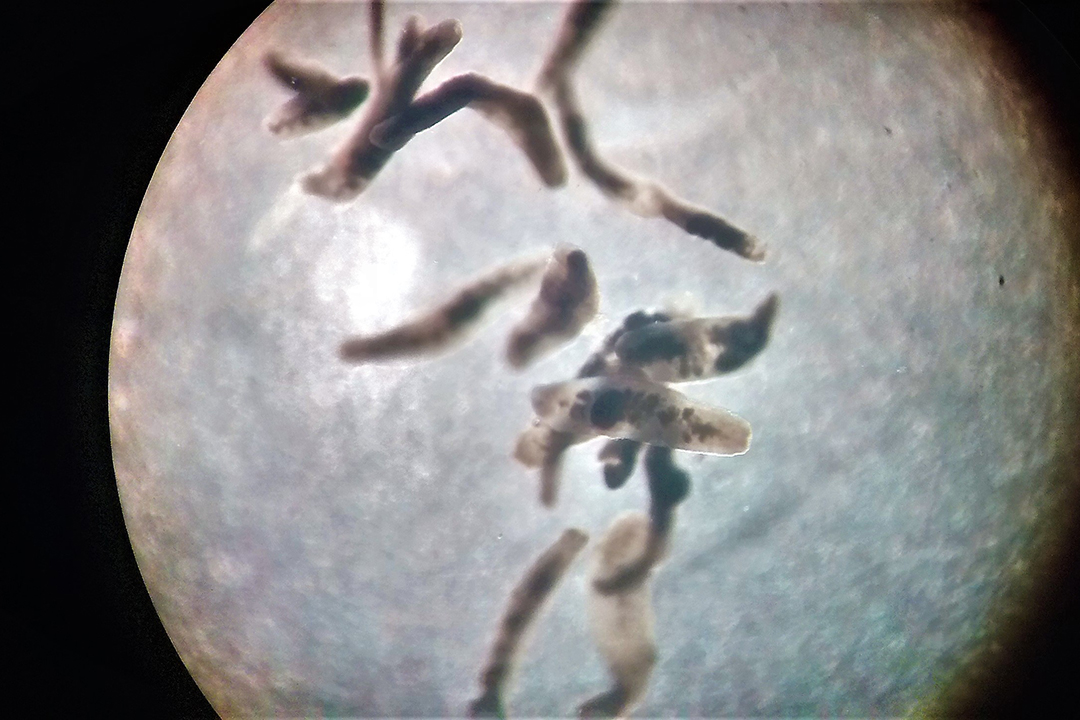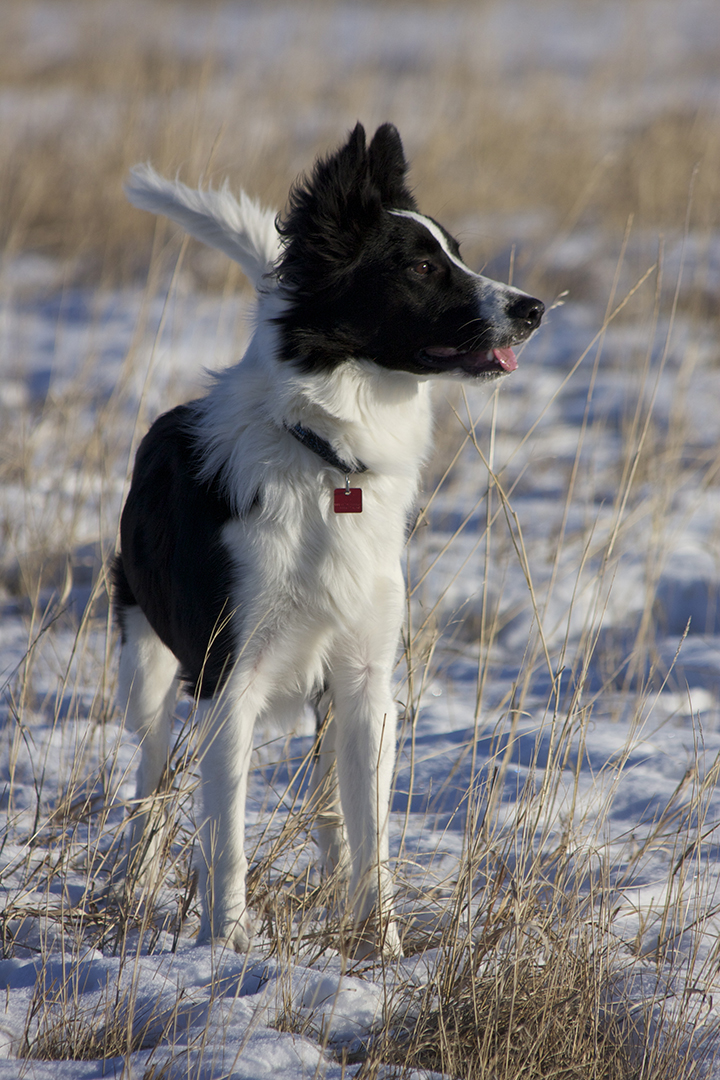
Tapeworm potentially risky for pets and people
The beauty of nature: lush forests, chirping birds, babbling brooks and intestinal parasites.
By Sarah Revell
While parasites may not be quite as photogenic, they are just as much a part of nature as their more picturesque hosts and scenery. Unfortunately, some of these parasites also have the potential to present serious public and veterinary health concerns – particularly when their life cycles veer off course. One such parasite is Echinococcus multilocularis.
This tapeworm is normally found in the small intestines of wild canids such as foxes, wolves, and coyotes. Its normal life-cycle begins with these infected carnivores, the definitive hosts. When these hosts shed the tapeworm eggs in their feces and contaminate the environment, the eggs are then accidentally ingested by rodents.
Once inside these intermediate hosts, the parasite forms grape-like cysts that are the larval form of the tapeworm. These parasitic cysts initially become established in the liver but as the infection progresses, the cysts can spread throughout the body.
The life cycle of the parasite is completed when a wild canid hunts and eats the infected rodent, allowing the tapeworms to mature and reproduce once again.
From a health perspective, problems arise when species that are not part of the parasite’s normal life-cycle accidentally ingest eggs – such as dogs, primates and people. Described as aberrant intermediate hosts, these infected individuals develop the larval stage of the parasite. These cysts then cause a disease called alveolar echinococcosis (AE).
In some areas of central Europe, AE has been endemic for hundreds of years – reports of human cases date back to the mid-19th century. But it wasn’t until the late 1980s that veterinarians began to identify cases of AE in the domestic dog population. Although the disease has remained rare, since then clinicians are still identifying new cases on a consistent basis.
On the other side of the Atlantic, the situation has been somewhat different. Until the summer of 2009, there had been no documented cases of AE in Canadian dogs.
But since then, veterinarians have identified new cases in British Columbia, Alberta, Saskatchewan, Manitoba and Ontario. While the total number of diagnoses remains low, these documented cases represent an unusual surge in an otherwise rare disease.
Researchers in central Europe have also seen an increase in the number of cases of AE, but it is difficult to determine whether these new cases represent a true increase in prevalence.
“I think there is an increase, but it could also just be that the practitioners are more aware of it,” says Dr. Caroline Frey, adjunct professor at the Western College of Veterinary Medicine (WCVM) and former Head of Veterinary Diagnostics at Switzerland’s University of Bern – Institute of Parasitology, who has conducted extensive research on E. multilocularis.
In Canada, the situation is similarly complex. New survey results and the emergence of new cases in dogs in areas previously thought to be E. multilocularis-free (such as B.C. and Ontario) are indications that this parasite’s geographic distribution may be spreading across Canada.
“Unfortunately, without really good baseline data, it’s almost always impossible to tell a true emergence from an increased detection effort,” says Dr. Emily Jenkins, an associate professor at the WCVM who specializes in parasitology.
For these reasons, Jenkins has been conducting surveillance for E. multilocularis in wild canids since 2009, including, most recently, in Québec. As well, she is working with a number of other veterinary clinicians, pathologists, and researchers across Western Canada to complete a survey of AE cases in domestic dogs. One of the main goals of the survey is to ensure that Canadian veterinary clinicians in general practice become more aware of AE as a potential diagnosis in their patients.
“It’s still very much not on practitioner radars here,” says Jenkins.
Because the disease is extremely rare and the symptoms often mimic those of an abdominal cancer, misdiagnosis is possible, particularly if the client opts out of further testing or surgical intervention.
In a 2015 study, Frey and her colleagues found that in many of the Swiss cases, AE was not diagnosed until after a dog had already been euthanized.
“[After] they sent in the material … we found out it was alveolar echinococcosis, but [the dogs] were euthanized on the suspicion of a malignant tumour of the liver. And of course, we don’t know how many times that happens without the actual lesion being sent in for diagnosis,” says Frey.
Jenkins hopes that as veterinarians become more aware of AE as a potential diagnosis, it can be detected earlier, which is associated with better outcomes for affected dogs. Increased awareness would also help researchers gain a more accurate picture of the prevalence of AE in Canada’s domestic dog population – and warn local public health authorities to be on the alert for human cases, since dogs and people can be exposed in the same ways.
Unfortunately, dogs aren’t just sending us a warning – because dogs are related to other canids, they can also shed eggs that can infect people. For this reason, any dog diagnosed with AE will be tested to see if it’s acting as a definitive host. But Frey points out that a dog diagnosed with AE is a relatively low risk to its owners.
“Usually at the time of AE diagnosis [a definitive host] because those worms – the adults – they each live about three months, and then they die again,” explains Frey. “So they’re not there for long. And if the dog is not a definitive host, but just an intermediate host, there is really no risk for the owner.”
Although dogs with AE pose a limited risk to humans, an increase in diagnosed cases of AE in dogs indicates an increase in environmental contamination with the parasite eggs – a significant concern for human health. These concerns are heightened by the recent diagnoses in western Canada of several locally-acquired cases of human AE.
But despite sharing these concerns, Frey also notes that it is important to maintain perspective.
“I think always when we talk about alveolar echinococcosis, it’s important to mention that humans are a bad host. So they’re hard to get infected and the disease develops really slowly,” says Frey.
“Having said that, each individual who has growth of the parasite has to be treated almost like a cancer patient, so it’s a serious disease. But we have to keep in mind that it’s a rare disease, and that probably only few people who get exposed to the parasite eggs will eventually develop the disease.”
Sarah Revell of Saskatoon, Sask., is a second- year veterinary student who was part of the WCVM’s Undergraduate Summer Research and Leadership program in 2017. Sarah’s story is part of a series of articles written by WCVM summer research students.
